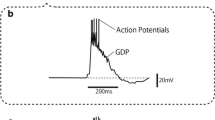Abstract
γ-aminobutyric acid (GABA) is an inhibitory neurotransmitter in adult mammalian central nervous system (CNS). During CNS development, the role of GABA is switched from an excitatory transmitter to an inhibitory transmitter, which is caused by an inhibition of calcium influx into postsynaptic neuron derived from release of GABA. The switch is influenced by the neuronal chloride concentration. When the neuronal chloride concentration is at a high level, GABA acts as an excitatory neurotransmitter. When neuronal chloride concentration decreases to some degree, GABA acts as an inhibitory neurotransmitter. The neuronal chloride concentration is increased by Na+-K+-Cl−-Cl− cotransporters 1 (NKCC1), and decreased by K+-Cl− cotransporter 2 (KCC2).
摘要
γ-氨基丁酸 (γ-Aminobutyric acid, GABA) 是成年哺乳动物中枢神经系统内的抑制性神经递质。在中枢神经系统发育过程中, GABA由兴奋性神经递质转变为抑制性神经递质。其转变过程主要表现为GABA的释放由促进突触后神经元的Ca2+内流变为抑制突触后神经元的Ca2+内流。中枢神经元内GABA作用的转变受细胞内Cl−浓度的影响: 当细胞内Cl−浓度处于高水平时GABA发挥兴奋性神经递质的作用, 当细胞内Cl−浓度降低到一定程度后GABA发挥抑制性神经递质的作用。升高中枢神经元内Cl− 浓度的是Na+-K+-Cl−-Cl− 同向转运蛋白1 (Na+-K+-Cl−-Clcotransporters1, NKCC1), 而K+-Cl−协同转运蛋白2 (K+-Cl− cotransporter 2, KCC2) 则使中枢神经元内Cl−浓度降低。
Similar content being viewed by others
References
Lin MH, Takahashi MP, Takahashi Y, Tsumoto T. Intracellular calcium increase induced by GABA in visual cortex of fetal and neonatal rats and its disappearance with development. Neurosci Res 1994, 20: 85–94.
Ganguly K, Schinder AF, Wong ST, Poo M. GABA itself promotes the developmental switch of neuronal GABAergic responses from excitation to inhibition. Cell 2001, 105: 521–532.
Martin DL, Martin SB, Wu SJ, Espina N. Regulatory properties of brain glutamate decarboxylase (GAD): the apoenzyme of GAD is present principally as the smaller of two molecular forms of GAD in brain. J Neurosci 1991, 11: 2725–2731.
Wu YM, Wang R, He RR. Urotensin II inhibits electrical activity of hippoCampal CA1 neurons by potentiating the GABAA receptor-mediated Cl− current. Neurosci Bull 2006, 22: 110–114.
Herlenius E, Lagercrantz H. Neurotransmitters and neuromodulators during early human development. Early Hum Dev 2001, 65: 21–37.
Stein V, Hermans-Borqmever I, Jentsch TJ, Hübner CA. Expression of the KCl cortransporter KCC2 parallels neuronal maturation and the emergence of low intracellular chloride. J Comp Neurol 2004, 468: 57–64.
Kaila K. Ionic basis of GABAA receptor channel function in the nervous system. Prog Neurobiol 1994, 42: 489–537.
Herlenius E, Lagercrantz H. Development of neurotransmitter systems during critical periods. Exp Neurol 2004, 190: S8–S21.
Ueno T, Okabe A, Akaike N, Fukuda A, Nabekura J. Diversity of neuron-specific K+-Cl− cotransporter expression and inhibitory postsynaptic potential depression in rat motoneurons. J Biol Chem 2002, 277: 4945–4950.
Giménez I. Molecular mechanisms and regulation of furosemide-sensitive Na-K-Cl cotransporters. Curr Opin Nephrol Hypertens 2006, 15: 517–523.
Chin DX, Fraser JA, Usher-Smith JA, Skepper JN, Huang CL. Detubulation abolishes membrane potential stabilization in amphibian skeletal muscle. J Muscle Res Cell Motil 2004, 25: 379–387.
Russell JM. Sodium-potassium-chloride cotransport. Physiol Rev 2000, 80: 211–276.
Breitwieser GE, Altamirano AA, Russell JM. Elevated [Cl−]i, and [Na+]i inhibit Na+, K+, Cl− cotransport by different mechanisms in squid giant axons. J Gen Physiol 1996, 107: 261–270.
Clayton GH, Owens GC, Wolff JS, Smith RL. Ontogeny of cation-Cl− cotransporter expression in rat neocortex. Brain Res Dev Brain Res 1998, 109: 281–292.
Hübner CA, Lorke DE, Hermans-Borgmeyer I. Expression of the Na-K-2Cl-cotransporter NKCC1 during mouse development. Mech Dev 2001, 102: 267–269.
Yamada J, Okabe A, Toyoda H, Kilb W, Luhmann HJ, Fukuda A. Cl− uptake promoting depolarizing GABA actions in immature rat neocortical neurones is mediated by NKCC1. J Physiol 2004, 557: 829–841.
Sung KW, Kirby M, McDonald MP, Lovinger DM, Delpire E. Abnormal GABAA receptor-mediated currents in dorsal root ganglion neurons isolated from Na-K-2Cl cotransporter null mice. J Neurosci 2000, 20: 7531–7538.
Dzhala VI, Talos DM, Sdrulla DA, Brumback AC, Mathews GC, Benke TA, et al. NKCC1 transporter facilitates seizures in the developing brain. Nat Med 2005, 11: 1205–1213.
Kahle KT, Rinehart J, de Los Heros P, Louvi A, Meade P, Vazquez N, et al. WNK3 modulates transport of Cl− in and out of cells: implications for control of cell volume and neuronal excitability. Proc Natl Acad Sci 2005, 102: 16783–16788.
Li H, Tornberg J, Kaila K, Airaksinen MS, Rivera C. Patterns of cation-chloride cotransporter expression during embryonic rodent CNS development. Eur J Neurosci 2002, 16: 2358–2370.
Hekmat-Scafe DS, Lundy MY, Ranga R, Tanouye MA. Mutation in the K+-Cl− cotransporter gene kazachoc (kcc) increase seizure susceptibility in Drosophila. J Neurosci 2006, 26: 8943–8954.
Mercado A, Broumand V, Zandi-Nejad K, Enck AH, Mount DB. A C-terminal domain in KCC2 confers constitutive K+-Cl cotransport. J Biol Chem 2006, 281: 1016–1026.
Rivera C, Voipio J, Kaila K. Two developmental switches in GABAergic signalling: the K+-Cl− cotransporter KCC2 and carbonic anhydrase CAVII. J Physiol 2005, 562: 27–36.
Author information
Authors and Affiliations
Corresponding author
Rights and permissions
About this article
Cite this article
Li, K., Xu, E. The role and the mechanism of γ-aminobutyric acid during central nervous system development. Neurosci. Bull. 24, 195–200 (2008). https://doi.org/10.1007/s12264-008-0109-3
Received:
Published:
Issue Date:
DOI: https://doi.org/10.1007/s12264-008-0109-3




